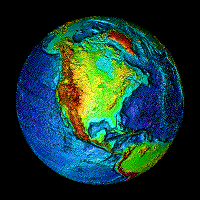Tending their Goaties at the Edge of Anthropocene
Posted by feww on March 28, 2010
Thank goodness geography is not an exact science!
“11 questions to shape geographical sciences research in the next decade”
As a new epoch dawns, prompting humanity to search for the largest cave, situated well above the sea level, but with running water and enough soil to cultivate fast growing, edible weeds, as far away from the nearest volcanoes, and with near-zero seismic history … to protect their backsides [it won’t happen that way, of course] …
Life in a Rockshelter

Daily life at Hinds Cave as depicted by artist Peggy Maceo. In the foreground two women sit on woven mats and prepare food while a baby sleeps to one side and two young girls intently watch (and learn). The woman on the left pulverizes parched nuts while the seated woman uses a parching basket to keep nuts and several red-hot coals in motion. At the rear of the cave, an elder sits wrapped in a rabbit-fur robe while her adult daughter weaves a new mat. Two young boys kick up dust as the older brother aims a stick at his younger sibling. The men must be out hunting [that’s what they’ll tell the kids, any way—Moderator.] Image courtesy of College of Liberal Arts, The University of Texas in Austin. Click image to enlarge.
The National Research Council has released a new report which poses eleven questions that they believe would shape the research in geographical sciences in the next decade. To their credit they have briefly touched on “a time when populations are moving and natural resources are being depleted,” honing their questions with the “aim to provide a more complete understanding of where and how landscapes are changing” so that the society could manage and adapt to the transformation that are occurring on the Earth’s surface.
The following expert is from the National Academy of Sciences latest public release:
11 questions for the next decade of geographical sciences identified
The committee that wrote the report solicited input from the geographical science community to identify research priorities and the approaches, skills, data, and infrastructure necessary to advance research. The strategic directions span from overarching issues of environmental change and sustainability to specific areas in the field that are transforming. They are grouped by topic area, but are not ranked in any order of importance.
How to understand and respond to environmental change:
- How are we changing the physical environment of Earth’s surface?
- How can we best preserve biological diversity and protect endangered ecosystems?
- How are climate and other environmental changes affecting the vulnerabilities of coupled human-environment systems?
How to promote sustainability:
- Where and how will 10 billion people live?
- How will we sustainably feed everyone in the coming decade and beyond?
- How does where we live affect our health?
How to recognize and cope with the rapid spatial reorganization of economy and society:
- How is the movement of people, goods, and ideas changing the world?
- How is economic globalization affecting inequality?
- How are geopolitical shifts influencing peace and stability?
How to leverage technological change for the benefit of society and environment:
- How might we better observe, analyze, and visualize a changing world?
- What are the societal implications of citizen mapping and mapping citizens?
Related Links:

Leave a comment